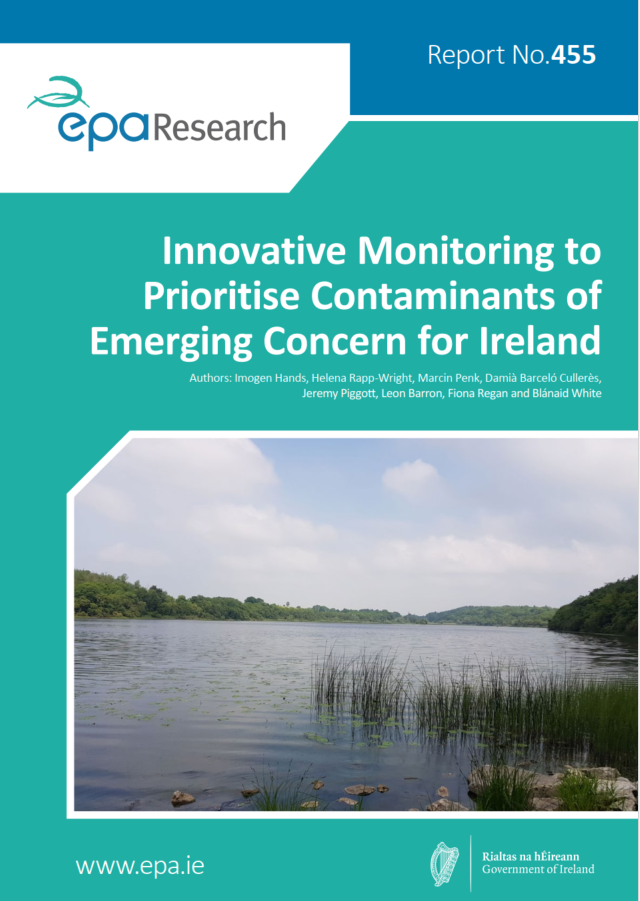Imogen Hands, Helena Rapp-Wright, Marcin Penk, Damià Barceló Cullerès, Jeremy Piggott, Leon Barron, Fiona Regan and Blánaid White
Summary: Contaminants of Emerging Concern (CECs) can be defined as “any synthetic or naturally occurring chemical or any microorganism that is not commonly monitored in the environment but has the potential to enter the environment and cause known or suspected adverse ecological and/or human health effects”. This research provides a comprehensive insight into the occurrence and fate of CECs in wastewater treatment effluent on entry to Irish receiving waters. Two wastewater treatment plants (WWTPs), one urban and one rural were monitored for one year to identify the temporal and spatial occurrence of more than 100 CECs in the aquatic environment and the WWTPs influents and effluents. This work allows contaminants that are not efficiently removed during treatment of municipal effluents to be highlighted and enables an evidence-based prioritisation list of CECs to be developed in Ireland.

Contaminants of emerging concern (CECs) can be defined as “any synthetic or naturally occurring chemical or any microorganism that is not commonly monitored in the environment but has the potential to enter the environment and cause known or suspected adverse ecological and/or human health effects”. This project provides comprehensive insight into the occurrence, fate and impact of CECs in Irish receiving waters. Influent, effluent and receiving waters from an urban and a rural waste water treatment plant (WWTP), representing worst-case scenarios, were comprehensively screened for pesticides, pharmaceuticals and personal care and cosmetic products over 1 year. The pressures on WWTPs were investigated by analysing the nature and concentration of CECs in influent samples. WWTPs are not designed to remove CECs, but the extent to which they could successfully remove CECs from influent water was also investigated. The extent to which CECs not removed during processing were diluted on entering receiving waters was also determined. This work allows contaminants that are not efficiently removed during treatment of municipal effluents to be highlighted and enables an evidence-based prioritisation list of CECs to be developed.
Article 16(4) of the Water Framework Directive (WFD) requires that the list of priority substances (Annex X of the WFD) must be reviewed and adjusted as appropriate at regular intervals. This happened in 2013 when 12 substances were added to Annex X, through Directive 2013/39/EU. Article 8b of the 2013 directive created a “watch list”, which was defined as a “list of substances for which EU-wide monitoring data are to be gathered for the purpose of supporting future prioritisation exercises”. For example, three compounds – diclofenac, 17β-estradiol and 17α-ethnylestradiol – were added in 2013, and a further 10 were added in 2015. Article 16 of the WFD requires that the Annex X list of priority substances be reviewed in future and that these reviews be informed by monitoring data gathered for watch list data. The analyses carried out in this research will provide a database of monitoring data for Irish and EU water bodies, to directly inform review of Article 16(4).
It is challenging to detect and monitor CECs using current analytical instruments. Two promising strategies highlighted in a recent EU Joint Research Centre report to overcome these issues were the use of modern mass spectrometric detection technologies and the sampling of greater volumes of water. We utilised the latest developments in both, including state-of-the-art instruments and methods at Imperial College London and the Catalan Institute for Water Research, to comprehensively analyse water samples from urban and rural WWTP influents and effluents, as well as receiving surface waters and freshwater river samples. In addition, we used passive sampling to monitor pesticide concentrations in surface waters, demonstrating the additional functionality of continuous monitoring as opposed to the point-in-time approach of grab sampling. This project demonstrated how utilisation of a range of sampling and analysis methodologies can result in a comprehensive overview of CEC presence and concentration, which in turn can be utilised to assess the environmental risk of these chemicals.
https://www.epa.ie/media/epa-2020/publications/research/Report-Cover-455.png